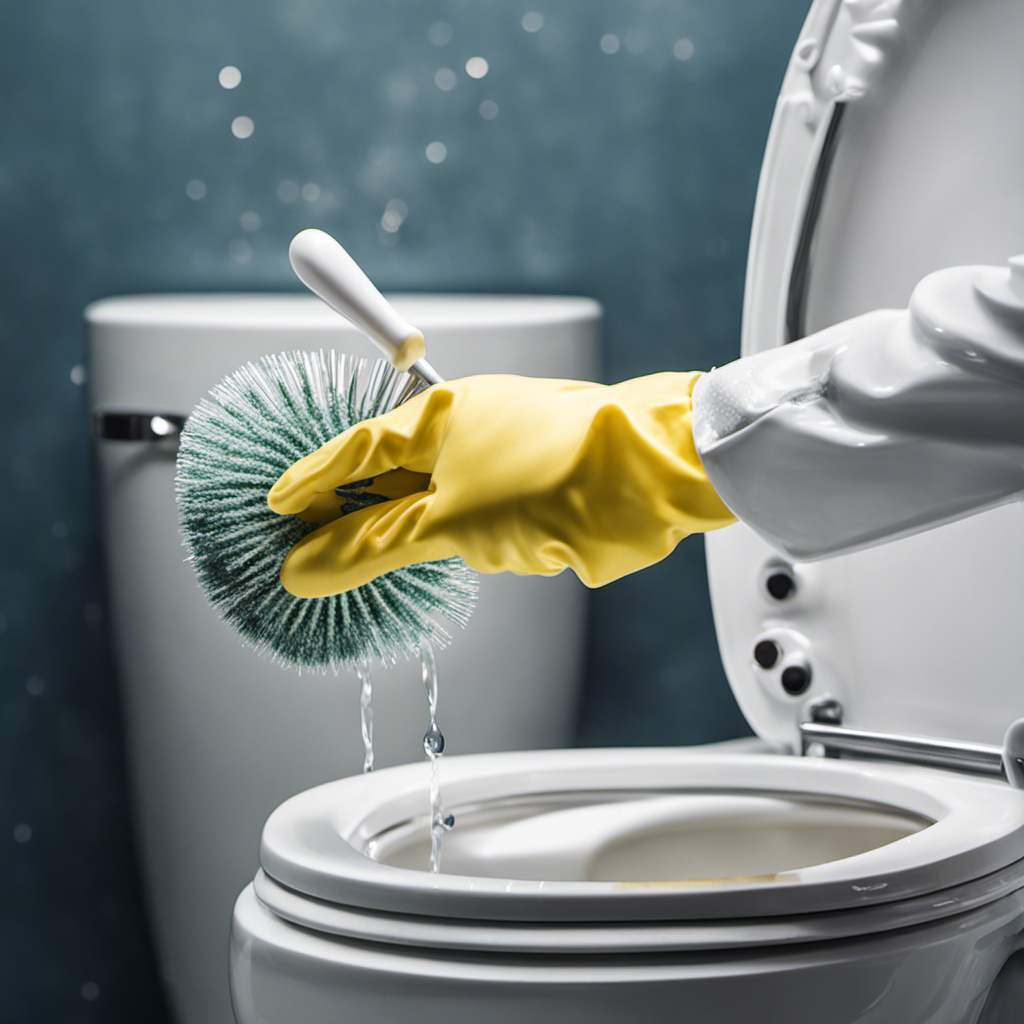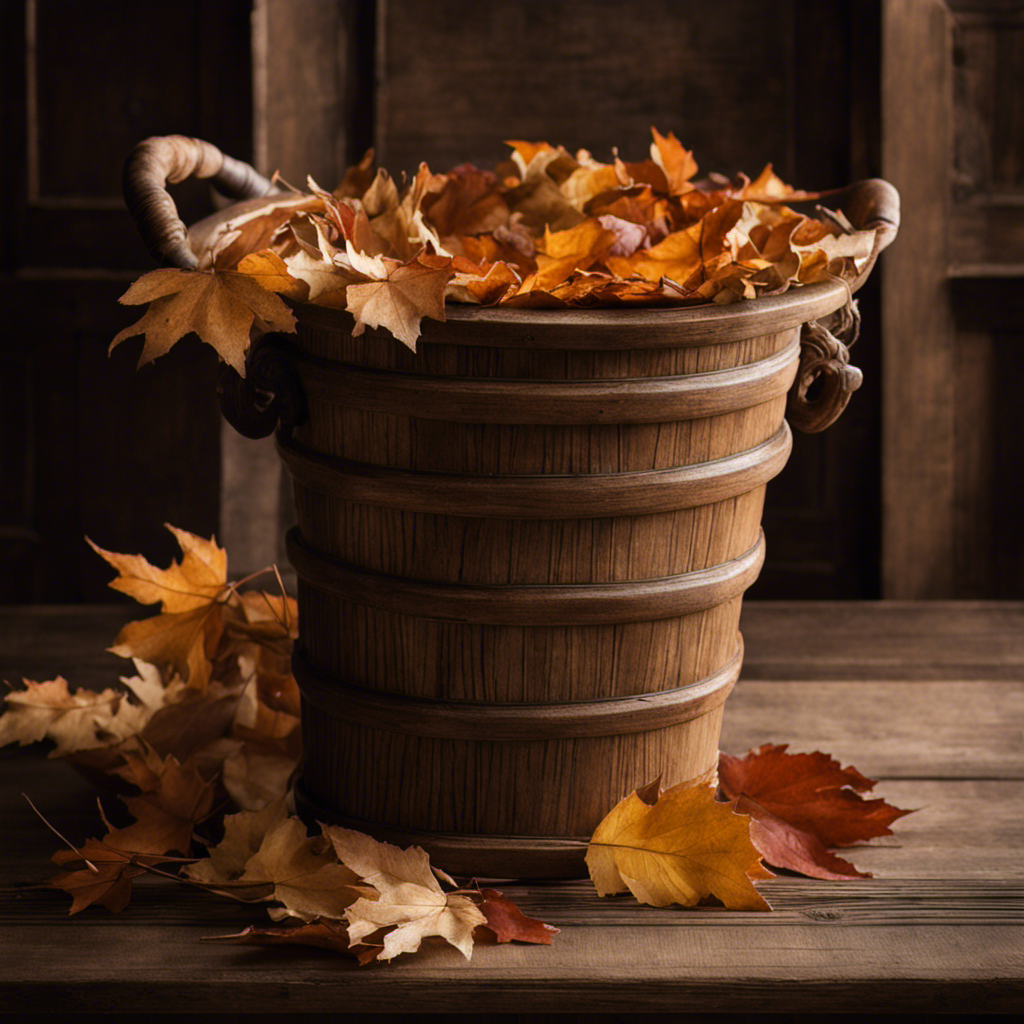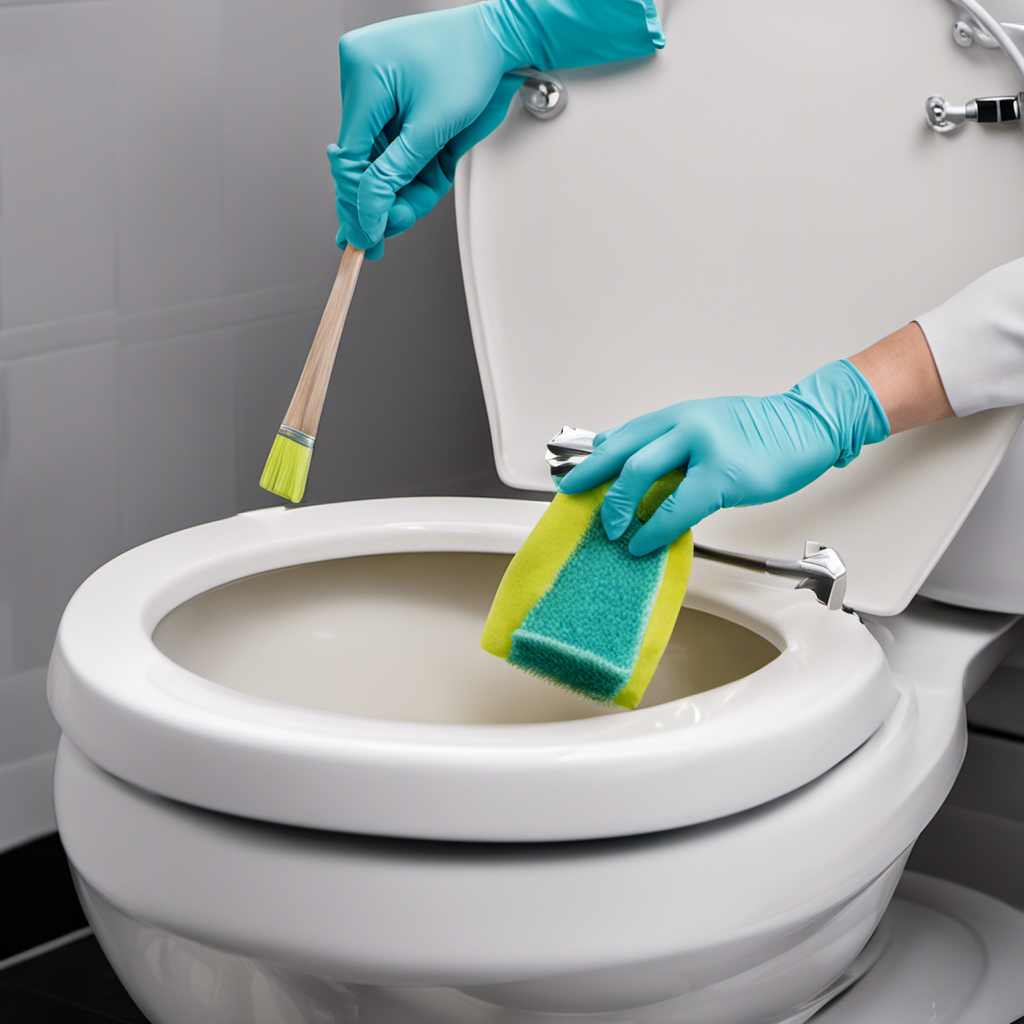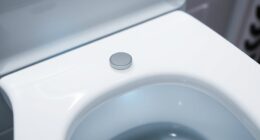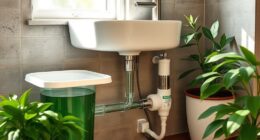As someone who has experienced the dreaded overflow of a toilet, I can attest to the importance of knowing how to properly sanitize and clean up after such a mess. In this article, I will guide you through the necessary steps to ensure a thorough and effective sanitization process.
From understanding the risks to gathering the necessary supplies, removing excess water and waste, disinfecting the affected area, dealing with odors and stains, preventing mold and mildew growth, to proper disposal and cleanup, I will equip you with the knowledge and tools to restore your bathroom to its pristine condition.
Key Takeaways
- Toilet overflows can create a breeding ground for harmful bacteria, posing a risk of gastrointestinal illnesses.
- Vulnerable individuals such as children and the elderly are particularly at risk and may experience dehydration.
- Water from overflows can lead to the growth of mold and mildew, requiring proper cleanup and sanitation steps.
- It is important to gather necessary supplies such as rubber gloves, disinfectant cleaner, microfiber cloths, and disposable bags before starting the sanitization process.
Understanding the Risks
Understanding the risks of unsanitized toilet overflows is crucial in preventing the spread of harmful bacteria. When a toilet overflows, it creates a breeding ground for various pathogens and contaminants. One of the main health concerns is the potential exposure to fecal matter, which can contain harmful bacteria like E. coli and Salmonella. These bacteria can cause severe gastrointestinal illnesses and lead to dehydration, especially in vulnerable individuals such as children and the elderly.
Additionally, the water from an overflowed toilet can seep into carpets, flooring, and walls, creating an environment for mold and mildew growth. Risks assessment is essential to evaluate the level of contamination and determine the necessary steps for proper cleanup and sanitation.
By understanding these risks, we can take the necessary precautions to protect our health and prevent the spread of diseases.
Now, let’s move on to gathering the necessary supplies for sanitizing after a toilet overflow.
Gathering the Necessary Supplies
First, you’ll need to gather all the necessary supplies. Here are the four essential items you’ll need to effectively sanitize after a toilet overflow:
-
Rubber gloves: Protect your hands from bacteria and germs by wearing rubber gloves throughout the cleaning process.
-
Disinfectant cleaner: Choose a cleaner specifically designed to kill bacteria and viruses. Look for one that is effective against a wide range of pathogens.
-
Microfiber cloths: These cloths are perfect for cleaning up spills and wiping down surfaces. They are highly absorbent and can effectively remove dirt and grime.
-
Disposable bags: Use disposable bags to safely dispose of any contaminated materials, such as used gloves or cleaning cloths.
Removing Excess Water and Waste
When dealing with a toilet overflow, it is crucial to properly dry the affected area to prevent further damage and the growth of mold or mildew. Using absorbent materials like towels or mops can help soak up the excess water and waste, while also ensuring that the area is thoroughly dried.
After drying, it is essential to disinfect all surfaces properly to eliminate any bacteria or germs that may be present. This can be done by using a disinfectant spray or wipes specifically designed for bathroom use.
Lastly, taking steps to prevent future overflows, such as regularly maintaining the toilet and being mindful of what is flushed down, can help avoid such incidents in the future.
Drying the Affected Area
To start drying the affected area, you’ll need to use absorbent towels or a wet/dry vacuum. Here are the essential steps and equipment needed for effective drying techniques:
-
Remove any standing water: Begin by soaking up as much water as possible using absorbent towels. Start from the outer edges and work your way towards the center to prevent the water from spreading further.
-
Use a wet/dry vacuum: If the area is large or the water is deep, a wet/dry vacuum can be a helpful tool. It can quickly extract water from carpets, floors, and upholstery.
-
Increase air circulation: Open windows and doors to allow fresh air to circulate. You can also use fans or dehumidifiers to speed up the drying process.
-
Monitor moisture levels: Use a moisture meter to check the humidity levels in the affected area. This will help ensure that everything is thoroughly dried and prevent the growth of mold or mildew.
Disinfecting Surfaces Properly
Properly disinfecting surfaces is essential to maintain a safe and sanitary environment. When it comes to effective cleaning, it is crucial to understand the importance of proper disinfection techniques.
To ensure that surfaces are thoroughly disinfected, it is recommended to use a disinfectant that is specifically designed to kill germs and bacteria. Look for products that contain active ingredients such as bleach, hydrogen peroxide, or alcohol, as these are known to be effective against a wide range of pathogens.
When applying the disinfectant, make sure to follow the instructions on the label, including the recommended contact time. It is also important to pay attention to high-touch areas such as doorknobs, light switches, and faucets, as these are more likely to harbor harmful germs.
Preventing Future Overflows
Now that you know how to properly disinfect surfaces after a toilet overflow, let’s talk about preventing future accidents. Here are some maintenance tips to keep your toilet from overflowing again:
-
Regularly check the water level in the tank and adjust the float valve if necessary. This will prevent excessive water from flowing into the bowl.
-
Avoid flushing excessive amounts of toilet paper or other non-flushable items down the toilet. Use a waste bin instead.
-
Inspect and replace worn-out or faulty parts, such as the fill valve, flapper, or flush handle, to ensure proper functioning of your toilet.
-
Consider installing a toilet overflow alarm or a shut-off valve that automatically stops the water flow if the water level gets too high.
Disinfecting the Affected Area
When cleaning up after a toilet overflow, make sure you thoroughly disinfect the affected area. Disinfecting techniques are crucial to prevent the spread of harmful bacteria and viruses.
To effectively disinfect, start by using disposable gloves and a face mask to protect yourself. Next, remove any visible waste and dispose of it properly. Then, use a disinfectant spray or wipe that contains at least 70% alcohol or bleach to sanitize the area. Pay special attention to high-touch surfaces like the toilet handle, seat, and surrounding floor.
Allow the disinfectant to sit for the recommended time before wiping it clean. Remember to also disinfect cleaning tools and wash your hands thoroughly afterwards. Recommended cleaning products include bleach, hydrogen peroxide, and EPA-approved disinfectants.
Dealing With Odors and Stains
To get rid of stubborn odors and stains, try using a mixture of baking soda and vinegar. This simple and effective solution can help eliminate the unpleasant smell and unsightly stains left behind after a toilet overflow.
Here are four steps to effectively deal with stubborn stains and eliminate lingering odors:
-
Sprinkle baking soda generously over the affected area. Baking soda is a natural deodorizer and can help absorb odors.
-
Pour vinegar onto the baking soda. The combination of the two ingredients will create a bubbling reaction that helps lift stains and neutralize odors.
-
Let the mixture sit for a few minutes to allow it to penetrate the stains and eliminate any lingering smells.
-
Scrub the area gently with a brush or sponge, then rinse thoroughly with water.
Preventing Mold and Mildew Growth
When it comes to preventing mold and mildew growth, there are three key points to keep in mind:
-
Drying wet surfaces: Drying wet surfaces immediately after they become wet is crucial, as mold and mildew thrive in damp environments.
-
Using disinfectant sprays: Using disinfectant sprays can help kill any existing mold or mildew spores and prevent further growth.
-
Ensuring proper ventilation: Ensuring proper ventilation in areas prone to moisture, such as bathrooms and kitchens, can help prevent the accumulation of moisture and create an environment where mold and mildew cannot thrive.
Drying Wet Surfaces
After the toilet overflows, it’s important to start drying wet surfaces as soon as possible. Moisture can lead to the growth of mold and mildew, which can pose health risks and cause damage to your home.
Here are four effective drying techniques to prevent further moisture-related issues:
-
Use absorbent materials: Grab towels, mops, or even paper towels to soak up the excess water. Press them firmly onto the wet surfaces to absorb as much moisture as possible.
-
Increase ventilation: Open windows, turn on fans, or use dehumidifiers to circulate air and promote faster drying. This helps in preventing the buildup of moisture and aids in drying the affected areas.
-
Utilize heat sources: Direct heat towards the wet surfaces. You can use a hairdryer on a low heat setting or even place portable heaters strategically to expedite the drying process.
-
Remove standing water: If there is standing water, use a wet/dry vacuum to remove it quickly. Standing water can seep into porous materials and cause further damage if not addressed promptly.
Using Disinfectant Sprays
Make sure you’re using disinfectant sprays on all surfaces to effectively eliminate germs and bacteria. Disinfectants are essential for maintaining a clean and hygienic environment, especially after a toilet overflow. To help you make an informed choice, I have compiled a table below showcasing the effectiveness of recommended disinfectant brands.
| Brand | Effectiveness | Recommended Usage |
|---|---|---|
| Lysol | Excellent | All surfaces |
| Clorox | Very Good | Hard surfaces |
| Dettol | Good | Bathroom areas |
| Microban | Good | High touch areas |
These brands have been proven to effectively kill germs and bacteria, ensuring a thorough sanitization. When using disinfectant sprays, remember to follow the manufacturer’s instructions for proper application and contact time. This will maximize the disinfectant’s effectiveness and provide a safe and clean environment. Now, let’s move on to the next step: ventilation to prevent moisture buildup.
Ventilation to Prevent Moisture
After discussing the use of disinfectant sprays to sanitize after a toilet overflow, it is important to address the issue of moisture control and ventilation techniques. These are crucial in preventing the growth of mold and mildew, which thrive in damp environments.
Here are four key methods to effectively control moisture and improve ventilation:
-
Open windows and doors: Allowing fresh air to circulate helps reduce humidity levels and promotes faster drying.
-
Use exhaust fans: Installing and using exhaust fans in bathrooms can help remove excess moisture from the air, preventing condensation and mold growth.
-
Dehumidifiers: Consider using dehumidifiers to maintain optimal humidity levels, especially in areas prone to dampness.
-
Regular cleaning and maintenance: Keep the bathroom clean and dry by promptly fixing any leaks, wiping down surfaces, and ensuring proper ventilation.
Proper Disposal and Cleanup
To properly dispose of the waste and clean up the area, it’s important to follow these steps.
First, ensure you have the necessary protective gear, such as gloves and a face mask, to maintain proper hygiene and prevent any potential health risks.
Next, use absorbent materials, like towels or paper towels, to soak up any excess water and waste. Place these materials in a sturdy garbage bag, making sure to tie it securely to prevent any leakage.
Disinfect the affected area using a bleach solution or an appropriate disinfectant, carefully following the instructions on the product.
After disinfection, thoroughly wash your hands with soap and warm water for at least 20 seconds to eliminate any bacteria or viruses.
Frequently Asked Questions
How Can I Prevent Toilet Overflows From Happening in the First Place?
To prevent toilet overflows, I make sure to avoid flushing excessive amounts of toilet paper or foreign objects. Regular maintenance such as checking the fill valve and flapper can also help identify and fix any issues before they cause an overflow.
Can I Use Regular Household Cleaning Products to Disinfect the Affected Area?
Yes, I can use regular household cleaning products to disinfect the affected area. However, it’s important to note that using bleach is the most effective method for sanitizing after a toilet overflow.
Is It Necessary to Wear Protective Gear While Cleaning up After a Toilet Overflow?
Yes, it is necessary to wear protective clothing while cleaning up after a toilet overflow. This is because there can be health hazards involved, and wearing appropriate gear helps to minimize the risk of exposure.
What Should I Do if the Toilet Overflow Has Caused Damage to the Flooring or Walls?
If the toilet overflow has caused damage to the flooring or walls, it’s important to act quickly. I would start by repairing the flooring and fixing the water damage to prevent further issues and maintain a clean and safe environment.
Are There Any Long-Term Health Risks Associated With Cleaning up After a Toilet Overflow?
Long-term health risks can arise from cleaning up after a toilet overflow. It’s important to take precautions and sanitize properly to avoid exposure to harmful bacteria and prevent potential health issues down the line.
Conclusion
In conclusion, taking the necessary steps to restore cleanliness and freshness after a toilet overflow is crucial. By understanding the risks involved, gathering the proper supplies, removing excess water and waste, and disinfecting the area, you can ensure a hygienic environment. Dealing with odors and stains and preventing mold and mildew growth are also important steps to take. Remember to dispose of waste properly and thoroughly clean up. With these techniques, you can restore your bathroom to its pristine state, leaving behind any unpleasant reminders of the incident.



